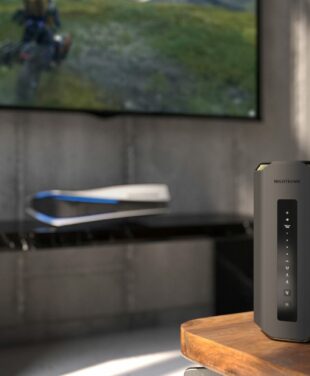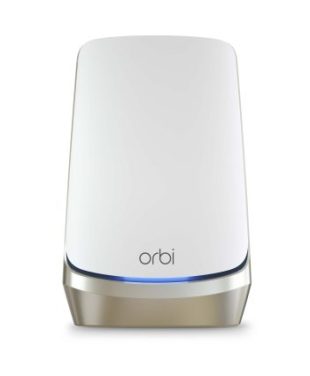In the evolving world of home networking, a question often arises: Can you add a WiFi extender to a mesh network? Let's delve into this topic and uncover the potential for augmenting and improving your wireless network.
IN THIS ARTICLE
Understanding Mesh Networks and WiFi Extenders
Firstly, it’s crucial to grasp the fundamental differences between mesh networks and traditional WiFi extenders. Mesh networks consist of multiple nodes working in unison to blanket your space with seamless WiFi coverage. WiFi extenders, on the other hand, are individual units that extend the reach of your existing WiFi signal.
How WiFi Mesh Networks Operate
Mesh WiFi technology is state-of-the-art WiFi. This WiFi networking setup uses several satellite nodes rather than a single access point, like a traditional stand-alone WiFi router. Because multiple router satellites broadcast WiFi in different locations throughout your home or office, mesh WiFi can provide a stronger and more reliable WiFi signal with faster WiFi speeds.
Mesh WiFi has changed the way we network during the past decade. Before mesh WiFi, a typical home setup consisted of a single device to handle WiFi. Traditional configurations include a router box with small antennas sticking out, a sleeker model with internal antennas, or an all-in-one WiFi router and modem. If you’re nearer to a stand-alone router, you will experience a stronger signal. Devices that are further away from the router experience a weaker WiFi signal.
If you are out of range, you are out of luck, with zero WiFi signal for connecting, apart from mobile data on your smartphone. In some ways, internet WiFi can be compared to a stereo system. The further away you are from the sound source, the more muffled and distorted the sound becomes. Using the same stereo system analogy, mesh WiFi can be compared to a sound system with smart speakers placed in different areas of your home. Each speaker broadcasts the sound clearly and strongly.
Mesh WiFi works similarly. One router node is the main WiFi access point connected to the modem for receiving the signal from your internet service provider (ISP). This part of a WiFi mesh network is identical to a traditional system, but that’s where the similarity ends, as mesh systems are scalable. The additional mesh nodes communicate wirelessly with each other and the main access point, resulting in blanket WiFi coverage for your whole home.
With whole-home mesh WiFi, the WiFi network signal remains strong wherever you are – upstairs, downstairs, or even out in the backyard by the pool. The best WiFi mesh systems, such as NETGEAR Orbi WiFi, include wired Ethernet ports on every satellite node for the best of both worlds.
The Difference Between Mesh WiFi and WiFi Extenders
WiFi range extenders have been around for a while, and you may be tempted to add a range extender to your current setup rather than opting for a WiFi mesh system. There are similarities between WiFi mesh and WiFi extenders, so what is the difference between the two options?
A quality NETGEAR WiFi range extender can be the right choice in some situations. For example, if you already have adequate WiFi coverage in your smaller home or apartment but could do with a little extra signal strength where a smart home application tends to drop offline, a WiFi 6 range extender might be all you need.
However, range extenders are not a fix-all in larger homes, and they may not provide the signal strength you need for high-bandwidth multi-gigabit activities such as streaming HD movies or real-time gaming. In most situations, tri-band mesh WiFi or the latest Orbi 970 WiFi 7 quad-band mesh will deliver the best WiFi performance available.
Unlike a WiFi extender layered on top of your existing WiFi network, a mesh network is one synchronised unit. All the components are designed and optimised to work in harmony, unified through the same firmware, interface, and settings. While WiFi extenders can’t generally communicate with each other, mesh nodes communicate seamlessly.
If you’re considering buying a WiFi extender to solve connectivity problems, it may be worth considering WiFi mesh instead.
So, Can You Add a WiFi Extender to a Mesh Network?
The short answer is yes. But, while it’s technically feasible to add a WiFi extender to a mesh network, it’s essential to consider whether it’s necessary or beneficial. Mesh network technology has moved on fast, from dual-band WiFi 5 to tri-band WiFi 6 and WiFi 6E, to the latest WiFi 7 mesh routers. NETGEAR Orbi and Nighthawk WiFi networking systems are a smart investment in future-proofing your home or office network for years to come. Mesh networks are inherently designed to eliminate the need for extenders by providing comprehensive coverage.
What Are the Benefits of Mesh WiFi?
Mesh systems can also be considered WiFi mesh extender (repeater) systems, but they are totally different from a random collection of traditional WiFi extenders. The benefits of mesh nest systems over a traditional router setup include improved WiFi coverage, simple management, and convenient scalability when you want more coverage. For the vast majority of internet users, a multi-node mesh WiFi system will solve all WiFi woes, even in WiFi dead zones.
Improved Coverage
If yours is a large or sprawling home with a complex design or lots of WiFi-blocking walls or other obstacles, a wireless router mesh network is a smart whole-home networking choice. The simple switch to a mesh network will deliver wall-to-wall WiFi coverage. It’s simply a matter of placing the satellite nodes optimally for best WiFi performance, and you can always add more nodes at a later date. Setup of NETGEAR Orbi is easy using the app on Windows, ore with your 5GHz Apple iPhone or Android smartphone.
Simple Mesh Network Management
Mesh network apps make the entire platform user-friendly, including options for parental controls, ad blocking, remote management, and smart home Internet of Things (IoT) integration. Orbi mesh is built for everyday Australians. You don’t have to be a techie to set up, operate, or maintain the system in optimal working order.
Convenient Scalability
If you’re using a traditional router and want more coverage, your options are to buy a more powerful router, a mesh system, or a WiFi extender. The convenient thing about mesh networks is that they are like a next-level network of sophisticated WiFi extenders designed to communicate with each other efficiently. Mesh networks are also scalable. If you buy a 3-pack Orbi mesh system and realise you need a little more coverage, simply add another satellite node to the configuration. Plus, the entire mesh network can be set up with a single password, so you won’t need to disconnect and reconnect as you move around your home.
NETGEAR Orbi: A Comprehensive Solution
NETGEAR Orbi is the number one choice for WiFi 6 systems and WiFi 7 systems Australia-wide. These robust whole-home mesh networks negate the need for WiFi extenders. Orbi offers seamless connectivity and speedy Mbps or Gbps speeds for data-hungry applications. NETGEAR Orbi will complement your existing router and take WiFi performance to the next level. Orbi’s advanced technology and easy setup make it easy to enhance your home network without replacing your current router. As one of the world’s most progressive WiFi companies, NETGEAR delivers the best WiFi 7 solutions to consumers in Australia.
Orbi 970 offers real-time WiFi performance for every corner of your home. Orbi WiFi 7 eliminates WiFi dead spots, and you won’t need to run additional Ethernet cables. Orbi 970 mesh delivers true multi-gig speeds and 360-degree whole-home coverage using innovative high-performance antennas. Orbi 970 allows you to connect up to 200 devices for concurrent use, with high throughput, multi-link operation, and low latency for an immersive online experience.
Orbi WiFi data transfer is instantaneous. Plus, the main Orbi router access point includes a 10 Gbps Ethernet port, four 2.5 Gbps Ethernet ports, and a 10 Gig Internet port. Orbi 970 satellites include a 10Gbps Ethernet port and two 2.5 Gbps Ethernet ports.
NETGEAR Orbi 970 WiFi Mesh in a Nutshell
NETGEAR Orbi 970 mesh is a WiFi game-changer. Here are some of the key Orbi 970 features worth considering for your WiFi system upgrade.
✔ WiFi 7 speeds of up to 27Gbps (potentially 40Gbps) for unparalleled performance and whole-home WiFi coverage.
✔ 2.4x faster speeds than WiFi 6 and fully compatible with older legacy devices and smart home applications.
✔ Exclusive quad-band technology and a dedicated backhaul channel for blazing-fast WiFi across all your network devices.
✔ 4K/8K streaming, multi-user video conferencing, high-definition gaming, virtual reality, augmented reality, and Metaverse immersion.
✔ Elegant Orbi 970 satellite design and high-performance antennas that deliver 360° WiFi coverage, even in difficult-to-access spaces.
✔ Seamless roaming and the strongest available WiFi connection throughout your entire home or office network.
✔ The fastest available internet speeds of today and tomorrow, including built-in 10 Gbps and 2.5 Gbps wired Ethernet ports for dedicated broadband device connections.
✔ NETGEAR Armor WPA3 security encryption for powerful protection against spam and malicious intruders, plus a comprehensive product warranty.
✔ The ability to synchronise Orbi 970 WiFi 7 with any internet service provider (ISP), plus easy setup and management of your WiFi network using the Orbi app.
Mesh WiFi Innovations for a Future-Proofed Network
NETGEAR Orbi whole-home WiFi 7 mesh is a genuine upgrade over WiFi 6 mesh systems. Orbi WiFi 7 includes optimised 2.4GHz, 5GHz, and 6GHz utilisation. Each WiFi band offers multiple channels of different widths, such as 20MHz, 40MHz, 80MHz, and 160MHz. Wider WiFi 7 channels offer more bandwidth to create a faster, stronger, and more reliable connection. Plus, WiFi 7 data can move in dual-band, tri-band, and quad-band streams. Here are just a few WiFi 7 innovations worth knowing about.
The new 320MHz channel band
WiFi 7 offers an all-new 320MHz channel. This doubles the available bandwidth compared to WiFi 6/6E. Orbi WiFi 7 also doubles the speed from 1.2 Gbps on the 160MHz stream to 2.4 Gbps on the 320MHz stream. WiFi 7 can offer up to 9.6 Gbps of bandwidth in total and also supports up to 16 partial streams. Theoretically, Orbi WiFi 7 can deliver data transfer rates of more than 40 Gbps, although you will need compatible WiFi 7 client devices to fully utilise the all-new 320MHz channel bandwidth.
4K Quadrature Amplitude Modulation (QAM)
QAM can manipulate radio waves to pack in more data. Orbi WiFi 7 supports 4096 QAM; that’s 4x the WiFi 6 capability of 1024 QAM. 4K QAM delivers superior performance when utilising the same channel width. Results include faster speeds, lower latency, and greater network efficiency compared to previous WiFi standards.
Multi-Link Operation (MLO)
Multi-link operation (MLO) is another good reason to choose NETGEAR Orbi WiFi 7. MLO aggregation can combine two different WiFi bands, such as the 5GHz and 6GHz bands, into a single WiFi network connection. This delivers higher network bandwidth for greater network reliability. Orbi whole-home mesh systems also use MLO to mesh the main access point and satellite nodes as one harmonious unit.
As you wander around your home, Orbi automatically hands the connection over to the strongest satellite signal. Multi-link operation delivers faster data rates over longer distances. MLO only works with WiFi 7-enabled client devices. Older WiFi 5 and WiFi 6/6E clients will still use a single band even when connecting.
Automated Frequency Coordination (AFC)
Automated Frequency Coordination (AFC) applies to the WiFi 7 6GHz band. This bandwidth offers faster speeds but has a shorter range compared to the 5GHz and 2.4GHz bands. AFC is an optional WiFi 7 feature that allows applications such as satellite services and broadcast companies to tap into parts of the 6GHz band. 6GHz broadcasters create an exclusive operating environment that won’t impact other 6GHz users. With WiFi 7, a broadcaster can use more power and improved antenna design. It’s estimated that AFC can offer 36 dBm broadcasting power, up to 36 dBm, up from the current 30 dBm max.
Preamble Puncturing
This all-new WiFi 7 feature can split a portion of the channel bandwidth into usable segments, allowing devices to connect with the unused portion. Previously, if part of a channel was in use, the entire channel would become unavailable for additional devices. Preamble Puncturing improves WiFi efficiency.
Additional highly effective technologies that are enhanced with Orbi WiFi 7 include Multi-User Multiple Input Multiple Output (MU-MIMO) and Orthogonal Frequency-Division Multiple Access (OFDMA). The future is now with NETGEAR Orbi 970 whole-home WiFi mesh.
Future-Proofing with NETGEAR Orbi
Orbi 970 WiFi 7 is changing the way we use the internet in Australia and around the world. WiFi 7 improves workplace productivity and profit, gives multi-player gamers a winning advantage, runs smart home Internet of Things (IoT) applications, and delivers the best available WiFi performance for everyone in your household. NETGEAR Orbi 970 offers faster data connections, wider channels, and more frequency bands. As more new devices are introduced with WiFi 7 capability, NETGEAR Orbi 970 is increasingly in demand.
Orbi WiFi 7 mesh systems are a savvy choice in today’s competitive networking environment. And as your network grows, you can add additional satellite nodes around your home or office to guarantee strong connectivity. You can even network in the garage, man cave, or outdoors by the pool. Orbi 970 beamforming antennas are specifically designed to direct powerful wireless signals at specific devices. Orbi 970 WiFi Advantages include:
• Eliminating WiFi dead zones in your household or office network
• Bypassing objects such as brick walls, solid objects, and dense materials
• Providing seamless WiFi coverage for large multi-story homes with complex layouts
• Offering blazing-fast multi-gigabit WiFi speeds for 200+ devices concurrently
• Creation of private networks, guest networks, and smart home networks
While adding a WiFi extender to a mesh network is possible, it’s a decision that requires careful consideration. For those who have invested in a high-quality mesh network like NETGEAR Orbi, the need for extenders is eliminated. The key is to assess your specific needs and understand the capabilities of your existing mesh network before opting for additional hardware. Speak to your NETGEAR retailer for more ideas and inspiration.
FAQs
Will an extender slow down my mesh network?
It depends on the extender’s quality and compatibility. It can slow things down if it operates on different WiFi frequencies or WiFi standards.
How do I know if I need an extender with my mesh network?
If yours is a large home or office space, a mesh WiFi system will provide optimal performance. Consider a traditional WiFi extender only if you have areas that are consistently out of your mesh network’s reach, despite optimal node placement.
Can I use any brand of extender with my mesh network?
While many extenders are universally compatible, it’s best to check for compatibility with your specific mesh system. Speak to your NETGEAR retailer for more guidance.
Is it better to add another mesh node instead of an extender?
Generally, adding another node to your mesh network is preferable, as it maintains seamless connectivity and convenient management of your network.




